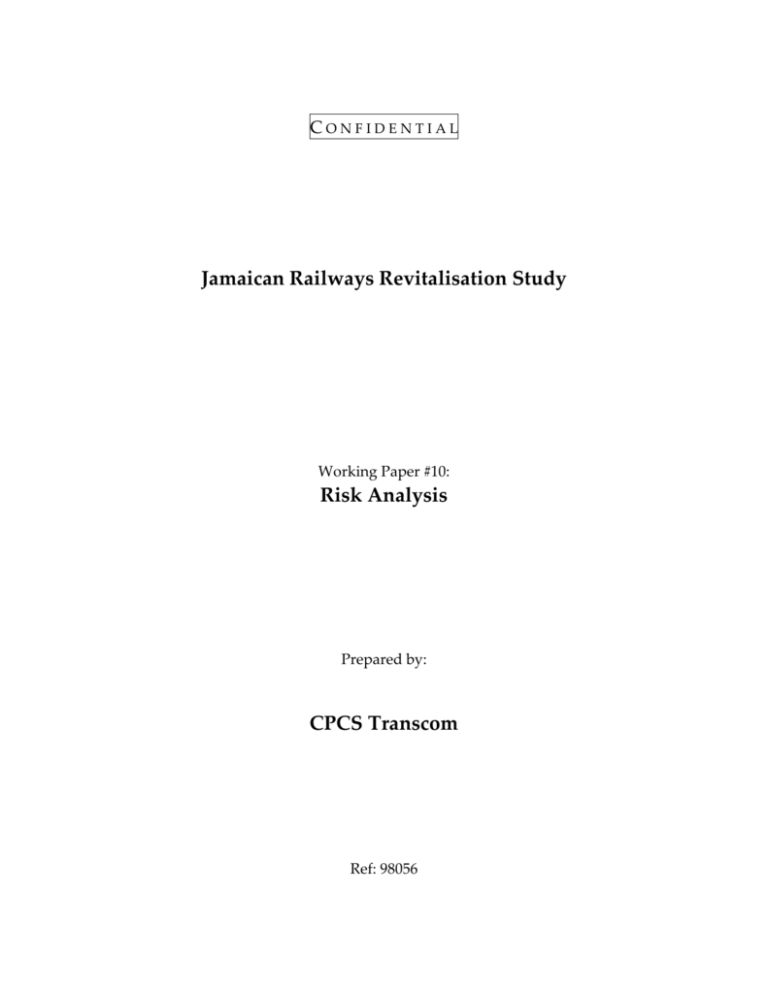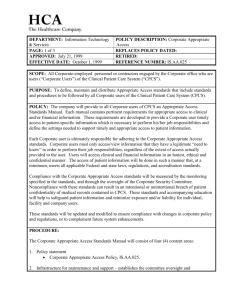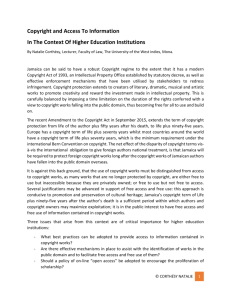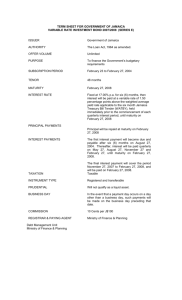Jamaican Railways Revitalisation Study
advertisement

CONFIDENTIAL
Jamaican Railways Revitalisation Study
Working Paper #10:
Risk Analysis
Prepared by:
CPCS Transcom
Ref: 98056
WP#10: RISK ANALYSIS
Note to the Reader
This is one of a series of Working Papers prepared by staff and consultants to CPCS
Transcom (CPCS) as input to its Detailed Feasibility Study on the Revitalisation of
the Jamaica Railways. These are interim documents designed to facilitate the
exchange of information and ideas both within the project team and between CPCS
and other stakeholders. As such, they are not to be construed as representing the
official policy or position of CPCS.
We gratefully acknowledge the assistance and support of the Government of
Jamaica, the National Investment Bank of Jamaica, the Jamaica Railway Corporation
and other organisations in the preparation of this document.
We also appreciate the financial support provided to the project by the Canadian
International Development Agency.
This report is the property of CPCS Transcom. No copies of this document or use of
any material herein shall be made without the express written consent of CPCS
Transcom.
CPCS TRANSCOM
ii
WP#10: RISK ANALYSIS
Table of Contents
1.
Introduction .......................................................................................................................... 1
1.1
Background ................................................................................................................... 1
1.2
Purpose of this Working Paper .................................................................................. 2
2. Risk, Returns & Railway Investments............................................................................... 4
2.1
General Principles ........................................................................................................ 4
2.2
Country Risk ................................................................................................................. 5
2.3
Sectoral Risk .................................................................................................................. 7
2.4
Project Risk .................................................................................................................... 9
2.4.1 Market Risks: ............................................................................................................ 9
2.4.2 Investment Risks .................................................................................................... 10
2.4.3 Political/social/institutional risk .......................................................................... 10
2.4.4 Investor reactions to project risk .......................................................................... 11
3. Risk Management Strategy ............................................................................................... 12
Appendix A:Project Risk: Container Terminal Investments ............................................... 13
Appendix B: Weighted Average Cost of Capital................................................................. 153
B.1
Introduction .............................................................................................................. 153
B.2
Real Cost of Project’s Debt ...................................................................................... 153
B.3
Real Cost of Project’s Equity................................................................................... 174
CPCS TRANSCOM
iii
WP#10: RISK ANALYSIS
1. Introduction
1.1
Background
The railway network in Jamaica is the oldest in the British Commonwealth outside the
United Kingdom. Freight and passenger services were suspended by the Jamaica
Railway Corporation (JRC) in 1992 owing to growing costs, declining revenues and the
consequent inability to fund maintenance of railway assets.
The Government of Jamaica (GoJ) has embarked upon a privatisation programme to
encourage private sector participation in selected parastatals. As a result, the National
Investment Bank of Jamaica (NIBJ), the GoJ’s authorised privatisation and divestiture
agency, was mandated to revitalise JRC by leasing the infrastructure and equipment to
a Government-approved private operator who would resume operations of the railway.
The NIBJ engaged Rail India Technical Services (RITES) to undertake a Feasibility Study
to assess the viability of revitalising the JRC. The RITES report submitted in September
1998 recommended revitalising the railway system and resuming freight and passenger
service for an investment of approximately US $40 million spread over three years. At
the time of the RITES report, the concept was for the GoJ to undertake railway
revitalisation prior to privatisation of the railway. Since the report, the GoJ and RITES
have reached an understanding whereby RITES, the NIBJ and other investors would
form a Joint Venture (JV) to revitalise and operate the railway.
CPCS Transcom (CPCS) has been given the opportunity to participate in the Joint
Venture to undertake JRC revitalisation and operation. Prior to committing to this
business venture, the JV partners require a detailed investigation of the project to
confirm its viability and to plan its implementation. In addition, CPCS will evaluate its
own role in the project and decide whether to proceed in this venture with RITES and
the NIBJ.
The Detailed Project Study of the Revitalisation of the JRC is a continuation of RITES’
Revitalisation of Jamaica Railways Corporation Study. The detailed study is being
carried out by CPCS and is funded jointly through internal CPCS resources and a grant
from the Canadian International Development Agency (CIDA).
CPCS TRANSCOM
1
WP#10: RISK ANALYSIS
1.2
Purpose of this Working Paper
The CPCS Detailed Project Study will include the following elements:
Detailed Market Study
Detailed Operations Analysis
Detailed Financial Analysis
Preparation of a Business Plan
Detailed Legal Study
Risk Analysis
Human Resources and Training Study
Environmental Impact Study
Social and Gender Impact Study
Preparation of Joint Venture Agreements and
Financial Advisory Services.
Together, these elements comprise a due diligence study of the project.
From the viewpoint of CPCS, the primary function of the study is to determine if the
project is viable and, if so, to establish if the project can be structured in such a way as
to provide a reasonable rate of return for an investment by CPCS. This is the “due
diligence” part of the study. If these conditions are met and if all the parties agree on
the proposed participation of CPCS Transcom in the project, the study will move
towards preparation of business plans and drafting and implementation of the required
agreements.
It should be noted that while CPCS shall share as much as possible of our analysis and
reports with RITES and NIBJ, all the reports shall remain the property of CPCS
Transcom and portions of the study will remain confidential to CPCS.
The objectives of this Working Paper are:
To summarize the perspectives of investors in infrastructure investments,
specifically railways, concerning risk;
To assess the risk profile of the Jamaica Railways Revitalisation project, drawing
upon our global experience in the transport sector; and
To identify a project framework designed to keep the risk within manageable
proportions. This analysis leads into our proposals in Chapter 4 for a
privatisation framework which is tailored to the specific conditions of the
Jamaican railway sector.
CPCS TRANSCOM
2
WP#10: RISK ANALYSIS
CPCS TRANSCOM
3
WP#10: RISK ANALYSIS
2. Risk, Returns & Railway Investments
This chapter focuses on the perspective of investors in railway ventures. We present
our understanding of the risk profile of the Jamaica Railways Revitalisation project,
drawing upon our global experience in the transport sector.
2.1
General Principles
Investors in any sector evaluate
their required rate of return
based on their appraisal of the
risks in a given venture. The
availability, type and cost of
financing also depend on the
perceived risk on the part of
lenders and potential equity
participants.
Figure 2-1: Risk/Return
Tradeoff
High
After
mitigation
strategy
RETURN
Before
mitigation
strategy
Risks and required returns
(profits, benefits) tend to be
Low
correlated (Figure 2.1). It follows
Low
High
that if the perceived cumulative
RISK
risk of a project can be reduced
through a mitigation strategy, the hurdle rate required by investors (and lenders) can
also be lowered and the probability of project implementation will increase.
International investments are subject to three main classes of risk :
Country risk, that is, the risks associated with investing in a particular location;
Sectoral risk, that is, the risks associated with investing in a specific industry; and
Project risk, that is, the risks inherent in a specific project.
Figure 2.2 illustrates the concept with reference to this project.
CPCS TRANSCOM
4
WP#10: RISK ANALYSIS
Figure 2-2: Categories of Risk Associated with the Project
– high fixed costs
– investment climate
COUN TRY
RISK
– exchange rate risk
SECTOR
RISK
– long payback period
– modal competition
– low labour productivity
– security risk
PROJECT
RISK
– magnitude of required investment
– market risk : service interrupted for 7 years
– market risk : short length of haul
– market risk : intermodal concept untried in Jamaica
Each class of risk requires a specific risk mitigation strategy on the part of the various
stakeholders in the project: the Government of Jamaica, multilateral agencies (if
applicable) and the Joint Venture (and its potential members).
2.2
Country Risk
“Country risk” can be broken down into a number of components related to the
political climate, the performance of the economy, perceived credit risk, financial
market conditions and social conditions (e.g., security). Another element of the country
risk is the institutional framework, notably the freedom of the rail operator to set tariffs
and determine the service configuration. The concept of country risk with reference to
Jamaica is addressed in the Textbox.
The important risk elements, which emanate from country and political risk, are:
Direct and indirect political risk which results in expropriation, creeping
expropriation, war, strike, public agitation, nationalisation, changes in law,
including terms of concession and other agreement, refusal to give consent, arbitrary
approvals required for the project under concession agreements, failure to
CPCS TRANSCOM
5
WP#10: RISK ANALYSIS
implement legislation required under concession agreement, failure to sign any
direct agreement as may be required by the lenders. In India, all the concession
agreement in infrastructure sector include specific guarantee from the Government
that in the event of such an event from the government side, it will result in a
payment to the concessionaire which should be equal to at least debt and interest
due plus lost dividend for the remaining concession period
Restriction on convertibility and transferability including increase in repatriation tax
or dividend repatriation itself. Normally this risk is managed under political risk
guarantee as given in the above paragraph under the change of law clause.
CPCS TRANSCOM
6
WP#10: RISK ANALYSIS
Country Risk: Jamaica
Twice each year, Euromoney magazine produces tables appraising country risk for
approximately 180 countries. While there is inevitably a subjective element to these
appraisals, the basis for the rankings is clearly documented (see Appendix 2 for an
explanation of each criterion and the scoring procedures).
The following table shows Jamaica’s ranking and score in the last three Euromoney country
risk appraisals. Jamaica is currently perceived to be riskier than most of its neighbours
(country rankings: Dominican Republic – 77; Trinidad & Tobago –60; Barbados 75; Jamaica –
90). The latest published rankings, prepared March 2000, indicated a deterioration in
perceived risk compared to September 1999. This was attributable exclusively to sharply
decreased scores for political risk and economic performance.
Criterion
Overall Ranking
Overall Country Risk Score
Political Risk
Economic Performance
Debt Indicators
Debt in Default or Rescheduled
Credit Rating
Access to Bank Financing
Access to Short-Term Financing
Access to Capital Markets
Discount on Forfeiting
Maximum
Possible
Score
1
100
25
25
10
10
10
5
5
5
5
Jamaica Score
March
2000
90
37.85
7.89
4.04
8.86
10.00
1.88
0.00
2.95
3.19
2.00
March
1999
81
40.42
7.93
5.02
9.40
10.00
2.50
0.62
2.95
1.88
0.00
December
1998
65
54.38
16.36
12.56
8.22
10.00
2.34
0.00
2.92
1.98
0.00
Source:
EuromoneyRisk
2.3 Sectoral
A number of risks are associated with railway investments because of fundamental
characteristics of the sector, characteristics often thought to be immutable before the
onset of railway restructuring. The primary such risk is the capital-intensiveness of the
railway industry. A healthy railway sector requires significant levels of investment. In
the United States, for example, the investment to sales ratio of the railway industry is
approximately 20%, higher than any other major sector. In addition, railways require
substantial ongoing expenditures to maintain the track – regardless of the volume of
traffic. Railways throughout the world face competition from trucks, which erode their
revenue base. State-run railways have generally lacked the commercial skills to
respond effectively. In addition, traditional work rules and operating practices have
harmed the competitiveness of the industry.
For the past twenty years, the railway sector has been in the throes of a restructuring
process which began in North America and has spread to other regions of the world.
CPCS TRANSCOM
7
WP#10: RISK ANALYSIS
The architects of the new railway industry have applied a variety of approaches to
address the fundamental weaknesses of the railway sector, as illustrated in Figure 2-3.
As a consequence, commercialised railways are characterised by heightened
responsivesness to market needs, greater operational flexibility, a cost structure which
is more variable, and higher productivity.
Figure 2-3: Railway Industry Risk Reduction Mechanisms
"POWER BY THE HOUR/MILE"
EQUIPMENT LEASING
SEPARATE INFRASTRUCTURE
FROM OPERATIONS
STRATEGIC ALLIANCES
RIGID CAPITAL STRUCTURE
PSO AGREEMENTS
PRIVATISATION /
RESTRUCTURING
LACK OF COMMERCIAL ORIENTATION
SHORT LINES
LOW LABOUR PRODUCTIVITY
NETWORK/SERVICE
RATIONALISATION
REVISED WORK RULES :
MULTI-TASKING
CAPITAL INVESTMENT
One of the most important changes, which occurred initially in Sweden and has spread
to other European countries and elsewhere, e.g. Chile, has been the creation of a
separate authority to manage railway infrastructure. The initial rationale was to
promote a “level playing field” between the trucks and buses, on the one hand, and rail,
on the other. The effect, when such a measure is implemented properly, is to make the
cost structure of the railways more flexible.1
In some cases, the railway infrastructure authority applies an access charge régime which mimics
that of the traditional railway industry – high fixed charges and a low variable charge. In such cases, the
effect of infrastructure separation can be to diminish the operational integrity of the railway without
providing an offsetting financial benefit.
1
CPCS TRANSCOM
8
WP#10: RISK ANALYSIS
2.4
Project Risk
In addition to the generic sector risks listed above, each railway project is subject to a set
of project-specific risks. In the case of the revitalisation of the Jamaica Railways, these
can be characterised as:
Market risks;
Investment risks; and
Political/social/institutional risks.
2.4.1 Market Risks:
As noted earlier, competition is a fact of life for railways (with the exception of those
resource railways which enjoy a natural monopoly). In Jamaica, the revitalised railway
will face the additional competitive challenges:
Resuming service after an interruption of more than seven years. The normal
concession experience is to take over a going concern. Even so, experience indicates
that traffic often falls during the transition period, as shippers react to market
uncertainty by switching to trucks. In the case of Jamaica, building market
credibility will be an even greater challenge;
Operating a short haul railway. An industry rule of thumb is that rail is
competitive with trucks over distances of 500 km and above. The World Bank’s
railway data base indicates that the average haul for most railways is considerably
longer than is achievable in Jamaica. Clearly, rail competitiveness depends upon a
range of factors including the competence of the railway, the quality of the roads,
the cost of diesel and the enforcement of truck size and weight regulations;
Implementing a multimodal service concept. In the 1980s, the main source of rail
traffic was the aluminum industry. JRC carried only a nominal volume of general
freight traffic. Rites has developed a multimodal freight service concept, based on a
network of terminals between Kingston and Montego Bay. The challenge will be to
offer a reliable, cost effective service which will persuade shippers to change their
transportation behaviour.
CPCS TRANSCOM
9
WP#10: RISK ANALYSIS
2.4.2 Investment Risks
The hiatus in the operation of the railway will impose a significant cost in terms of
infrastructure rehabilitation, repairs to buildings and refurbishing, rehabilitation and
acquisition of rolling stock.
A rule of thumb in the railway industry is that a dollar of investment should generate a
dollar of annual revenues. The indicative business plan developed by Rites in their
report of November 1998 assumed total investments of almost US$40 million, while
annual revenues were projected to peak at approximately $20 million. Track
rehabilitation will be the major focus of investment spending, particularly to restore the
segment between Williamsfield and Montego Bay to serviceable condition.
Clearly, the revenue base, as projected in that report, is insufficient to support the
requirements of a commercial railway operation in the absence of strategies to
address the challenge. One of the critical thrusts of the Business Plan for the Jamaica
Railways of the future will be to reduce the capital investment burden of the project
without compromising safety or commercial success.
2.4.3 Political/social/institutional risk
All restructured railways face this type of risk to a degree. Railways have long been an
instrument to achieve political and social objectives such as mobility, full employment,
energy/environmental conservation and regional development. Investors, on the other
hand, have commercial goals. The reconciliation of the needs of the public and private
sectors hinges upon the development of a transparent, fair, commercially oriented
transport policy framework. This would incorporate freedom to set rates and
compensation for Public Service Obligations.
In Jamaica, the railway operator faces two additional concerns:
Sharp devaluation of currency or runaway inflation rate.
Delay in repair/ rehabilitation of infrastructure, such as track, bridges, stations and
tunnels during the concession period
Security, both for passenger on trains and for goods in transit; and
Encroachments on the railway right-of-way.
CPCS TRANSCOM
10
WP#10: RISK ANALYSIS
2.4.4 Investor reactions to project risk
As with all other kinds of risk, investors adopt a number of approaches to mitigate
project risk:
Reducing equity requirements by leasing;
Seeking debt instruments with favourable terms (interest, principal repayment,
collateral requirements, etc.);
Requiring higher rates of return (higher hurdle rate).
However, all of the above may not be possible or sufficient to mitigate the risks. Lease
rentals are likely to be higher than pure debt. In a high country and high project risk
context, seeking appropriate debt terms on a “project recourse basis” may prove
difficult. Higher required rate of return coupled with a higher interest rate may make
further project difficult. In such cases, the role of Government is very important.
Governments can under such circumstances mitigate the risks through a balanced
concession agreement, by taking over political risks, force majeure risks on
infrastructure etc.
Empirical estimates of investor project risk premiums are well developed for sectors
such as oil and gas exploration. For rail, the evidence is mainly anecdotal. The table in
Appendix 1, developed by a respected international shipping consultancy, shows the
impact of project risk on required returns for private investors in container terminals,
based on the maturity of the regional container market and the state of development of
the terminal site leased to the private operator.
For projects involving “greenfield” cites, the spread is significant compared to projects
in mature (tested) markets. In the current context, Jamaica Railways is analogous to a
greenfield site.
CPCS TRANSCOM
11
WP#10: RISK ANALYSIS
3. Risk Management Strategy
The appropriate risk management strategy for this project, based on the analysis in
Chapter 2 consists of the following elments:
Establishing the required rate of return for CPCS Transcom at a level which
reflects country-, industry- and project-specific risk. This is being done as part of
the financial modelling of the concession. Our estimate of the Weighted Average
Cost of Capital for the project and its component elements is attached as Appendix
1. The important issue therefore would be to get requisite concession/ comfort from
the GOJ to achieve required rate of return if the project is capable of achieving on its
own merit.
Structuring the concession agreement to define clearly the roles and
responsibilities of the Joint Venture and the GOJ, notably with respect to capital
investment. The fundamental principle is that the Joint Venture should be
responsible for investments in train operations, while the GOV would be
responsible for infrastructure investments including timely repair/ rehabilitation in
case of natural force majeure effecting infrastructure, including track, bridges,
stations and tunnels;
A staged implementation of the services of the revitalized Jamaica Railways, as
documented in the Draft Business Plan; and
Utilization of leased assets where practical versus purchases, as a means of
limiting the equity requirements of the concession and allowing funding of
operations from cash flow.
CPCS TRANSCOM
12
WP#10: RISK ANALYSIS
Appendix A:
Project Risk:
Container Terminal Investments
CPCS TRANSCOM
13
WP#10: RISK ANALYSIS
Table A-1: CONTAINER TERMINAL RISK RETURN MATRIX - Typical Returns Required by a Pri
STATE OF DEVELOPMENT
OF TERMINAL SITE
LEASED TO PRIVATE
OPERATOR
Undeveloped site, operator
expected to provide
infrastructure to site (roads,
breakwater, etc.)
Greenfield site with
infrastructure developed to
site boundary
Improved site with a
quayline, paved yard, but
without buildings or
handling equipment
All civil works completed
and buildings on site but no
handling equipment
Fully developed site
including quay cranes but
without yard handling
equipment
Operator only supplies
technical expertise for a
management fee
Market
not
established
and
forecasts are based
on
transshipment
cargo
or
the
development of a
free trade zone
Market established
and
based
on
transshipment rather
than
hinterland
cargo
Market not yet
established but the
economy generates
high value general
cargo available for
containerisation
Established mark
but with low barrie
to entry for oth
terminal operators
Unbankable
without subsidy
Unbankable
without subsidy
Unbankable
without subsidy
Unbankable witho
subsidy
Unbankable
without subsidy
Unbankable
without subsidy
Unbankable
without subsidy
26% IRR
Unbankable
without subsidy
Unbankable
without subsidy
Unbankable
without subsidy
25% IRR
Unbankable
without subsidy
26% IRR
24% IRR
23% IRR
25% IRR
23% IRR
21% IRR
20% IRR
Flat fee of about
$500 k net
Flat fee of about
$500 k net
Flat fee of about
$500 k net
Flat fee of about
$500 k net
Source: Drewry Shipping Consultants, as reported in World Container Terminals: Global
Growth and Private Profit (1998)
CPCS TRANSCOM
14
WP#10: RISK ANALYSIS
Appendix B: Weighted Average Cost of
Capital
B.1
Introduction
We have used a discount rate i.e. Weighted Average Cost of Capital (WACC) to discount
projected cashflows of the project. The discount rate calculated below is our assumption of
how the investors would perceive as the risk of investing in a private business in Jamaica.
This discount rate is computed as follows:
WACC = Real (inflation adjusted) cost of project’s debt + Real cost of project’s equity
WACC= 9.31% + 9.7%
WACC= 19.00%
The above two costs are estimated as below:
B.2
Real Cost of Project’s Debt
The project company's cost of the debt portion (of the proposed capital) is assessed as
follows:
The average rate of long term industrial loans in Jamaica is estimated (23% p.a. of 2-5 year
average tenor, add 300 bp for increased tenor of 15 to 20 years and 200 bp for project risk)
and adjusted by the current inflation rate (CPI statistics for 1999) in Jamaica. The real debt
rate is then adjusted by the applicable corporate tax rate (33%) to get the return on debt.
CPCS TRANSCOM
15
WP#10: RISK ANALYSIS
Debt ratio x {[(1+ average long term debt rate ) / (1+ current inflation in Jamaica) -1] x (1tax rate)}
0.70 x {[( 1 + 0.23+.3+.2) / (1 + 0.068) - 1] x (1 - 0.33)} = 9.31 %
CPCS TRANSCOM
16
WP#10: RISK ANALYSIS
B.3
Real Cost of Project’s Equity
The cost of equity portion (as per the proposed debt/equity ratio) of the proposed capital is
assessed using the Capital Assets Pricing Model i.e.
Equity ratio x {Risk free rate of return + [Industry specific beta x Risk premium]}
which essentially expresses the required return on equity as the risk-free rate of return
plus a risk premium expressed as the difference between the expected market return and
the risk-free rate of return times the industry-specific beta. Beta is a measure of volatility
(riskiness) of the industry vis-à-vis the stock market as a whole.
0.30 x { 12.82% + [1.06 x 18.42% ] = 9.7%
1)
Risk free rate = corporate real debt rate in Jamaica x (U.S. risk free rate / corporate yield in U.S.)
The risk free rate can be estimated based on the 15.17% estimated average corporate real
debt rate in Jamaica, multiplied by the ratio of the US risk free rate (30-year Treasury
notes, currently 5.83%) to the US corporate yield (currently 7.67 %). Note that both US risk
rates are in nominal terms; the implicit elements of inflation in effect cancel out in the ratio
of the two rates.
Risk free rate = 15.17% x (5.83/7.67)
= 11.53%
The medium term foreign currency debt of Jamaica has been given “Ba3” rating by Moody
and “B” by Standard and Poor. The country has recently placed US$225 million sovereign
debt for a seven-year period at a yield of 13.125%. Considering the US$ inflation rate of
approximately of 2% and spread expectation of 300 bp for higher tenor as well as project
risk, the average risk free real interest rate shall not be less than 13.125+.3-.2 = 14.125%.
This does not compare well with the average risk free interest rate calculated above.
However, assuming sound economic policies of GOJ, it is hoped that interest rates will go
down during the period of raising the loans. For the purpose of calculating the risk free
rate, an average figure of 11.53 and 14.125% has been adopted which works out to be
12.8%.
2) The beta for the railroad industry in the US is currently 1.06 (based on 1998 figures),
which we have used for our analysis as no comparable data exists in Jamaica though
beta for railroad in Jamaica should logically be higher than for the railroad industry in
US, as the later are well established and long haul.
CPCS TRANSCOM
17
WP#10: RISK ANALYSIS
3) Risk premium = US equity risk premium x (US Risk Rating/Jamaica Risk Rating) + US small
stock premium
For estimating the appropriate risk premium for equity investments (relative to risk-free
investing), we are using long-term average yield differences between equities and
government paper, adjusted for risk. Information on historical differences is not available
for Jamaica, therefore, US data has been used. The geometric mean difference for the
period 1926-1998 is 5.0 percentage points. To adjust this measure for differences in country
risk perceived by the international investor, we have used risk ratings (published in March
2000) by a standard source, Euromoney magazine.
Thus, we have calculated risk premium as follows:
Risk premium = 5.00% x (94.04/37.85) + 6.00%
= 18.42%
CPCS TRANSCOM
18







